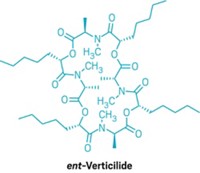Advertisement
Grab your lab coat. Let's get started
Welcome!
Welcome!
Create an account below to get 6 C&EN articles per month, receive newsletters and more - all free.
It seems this is your first time logging in online. Please enter the following information to continue.
As an ACS member you automatically get access to this site. All we need is few more details to create your reading experience.
Not you? Sign in with a different account.
Not you? Sign in with a different account.
ERROR 1
ERROR 1
ERROR 2
ERROR 2
ERROR 2
ERROR 2
ERROR 2
Password and Confirm password must match.
If you have an ACS member number, please enter it here so we can link this account to your membership. (optional)
ERROR 2
ACS values your privacy. By submitting your information, you are gaining access to C&EN and subscribing to our weekly newsletter. We use the information you provide to make your reading experience better, and we will never sell your data to third party members.
Pharmaceuticals
Arthur C. Cope Scholar Awards
by Susan J. Ainsworth
February 25, 2008
| A version of this story appeared in
Volume 86, Issue 8
Thomas S. Scanlan took his first organic chemistry class as an undergraduate at the University of Oregon 26 years ago and he says he "was hooked immediately and knew that organic chemistry was going to be the focus of my career."
True to that prediction, organic chemistry plays a central role in all of Scanlan's research, which has resulted in "immensely important contributions to the understanding of nuclear hormones, which modulate many vital physiological functions," according to Jonathan A. Ellman, professor of chemistry at the University of California, Berkeley.
Scanlan, 46, has been professor of physiology and pharmacology and director of the chemical biology program at Oregon Health & Science University, in Portland, since September 2006. Before that, he had been a professor of pharmaceutical chemistry at UC San Francisco, his professional home after earning a Ph.D. in chemistry from Stanford University in 1989 and completing a postdoctoral fellowship in bioorganic chemistry at UC Berkeley in 1991.
With a market value of billions of dollars per year, drugs targeting nuclear hormone receptors are rapidly increasing in importance even though their function is not yet well-understood, Ellman adds. Two of Scanlan's contributions "are of such profound significance that they have dramatically altered both research and drug discovery in the nuclear hormone field."
First, Scanlan has "demonstrated exceptional insight and medicinal chemistry acumen in his design and development of a synthetic derivative of a thyroid hormone that is selective for the β-subtype of thyroid hormone nuclear receptors (TRβ)," Ellman says. By targeting TRβ present in the liver but not the α-subtype receptor in the heart, Scanlan was able to lower cholesterol in both rodent and cynomolgus monkeys without the undesirable increase in cardiac drive that is observed for thyroid hormones. "This work is of huge potential therapeutic significance because it defines a new strategy for lowering cholesterol," Ellman adds.
This synthetic derivative is under clinical development by Ann Arbor, Mich.-based QuatRx Pharmaceuticals. "Having a compound discovered in my lab enter into clinical trials is my most rewarding accomplishment," Scanlan says, especially in light of "the current national emphasis on fostering research that translates basic discoveries into new medicines."
Still, Ellman says, Scanlan's "most impressive achievement" may be his recent discovery of a new set of thyroid metabolites, called thyronamines, which mediate powerful and rapid responses in vertebrate physiology. His research "establishes a completely new signaling pathway that leads to rapid physiological consequences that are opposite those associated with the action of the nuclear hormone thyroxine," which increases basal metabolic rate, Ellman says. Consequently, this work has the potential "to have a huge impact" upon strategies for the treatment of metabolic disorders related to thyroid hormone imbalances, he adds.
Making major strides in the understanding of thyroid hormone action, Scanlan and his colleagues have made compounds that are likely to become drugs for the treatment of major diseases including dyslipidemia, obesity, and diabetes, notes Peter G. Schultz, professor of chemistry at Scripps Research Institute, La Jolla, Calif. Schultz adds that with thyronamines, Scanlan may have discovered "an entire arm of thyroid hormone endocrinology" that could have "profound implications for chemistry, biology, and medicine."






Join the conversation
Contact the reporter
Submit a Letter to the Editor for publication
Engage with us on Twitter